 |
 |

 |
k | n | o | w |
 Learning to read, or getting better at reading, is easy with the PQs Pop-Up App. There are only a few steps you have to learn. 1) Click on every word you don’t recognize. 2) Try to read the word in the Pop-up. If you can’t, click the word in the pop-up again. 3) Repeat clicking it, and trying to read it, until you recognize the word. Click here for a guided tour of using the 3 steps.
Learning to read, or getting better at reading, is easy with the PQs Pop-Up App. There are only a few steps you have to learn. 1) Click on every word you don’t recognize. 2) Try to read the word in the Pop-up. If you can’t, click the word in the pop-up again. 3) Repeat clicking it, and trying to read it, until you recognize the word. Click here for a guided tour of using the 3 steps.

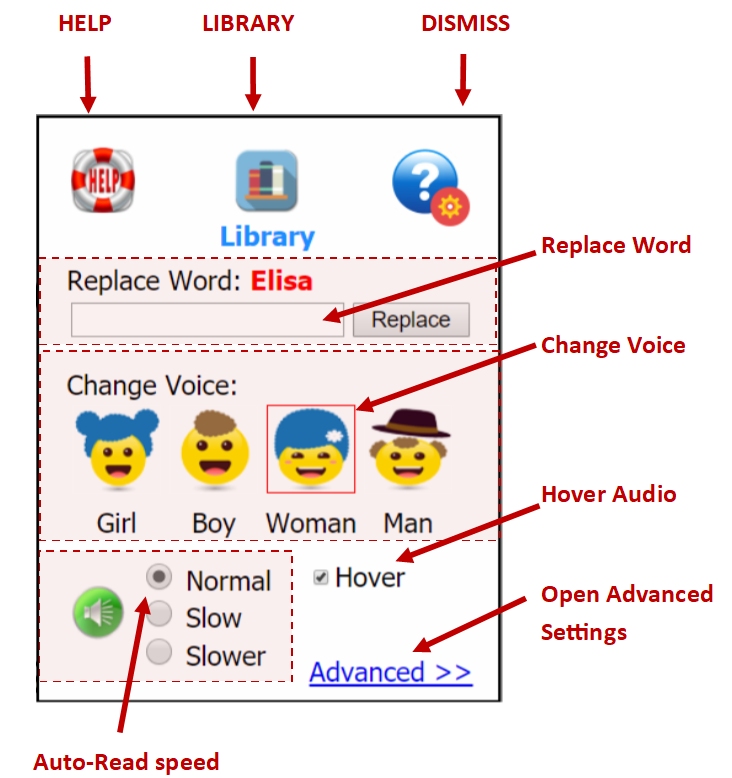 Help / Settings:
Help / Settings:
 The Help/Settings button can be found on the top right of every page. Clicking it opens the Help/Settings dialog box:
The Help/Settings button can be found on the top right of every page. Clicking it opens the Help/Settings dialog box:
 Help Center – Opens this page.
Help Center – Opens this page.
 Library – Return to the Library.
Library – Return to the Library.
 Dismiss. Clicking on the Help/Settings Icon or anywhere outside the Settings Dialog Box will dismiss the box and return you to the page you were viewing.
Dismiss. Clicking on the Help/Settings Icon or anywhere outside the Settings Dialog Box will dismiss the box and return you to the page you were viewing.
 Replace Name/Word (optional) – When a publication has a name or word that can be replaced with a word that will personalize the publication for your learner, the Replace Word option box will appear with the replaceable word displayed in red. By typing a word in the box (word should be no more than 4 characters longer than the displayed word), and then clicking the “Replace” button, the system will replace the replaceable word with the word you entered throughout the document.
Replace Name/Word (optional) – When a publication has a name or word that can be replaced with a word that will personalize the publication for your learner, the Replace Word option box will appear with the replaceable word displayed in red. By typing a word in the box (word should be no more than 4 characters longer than the displayed word), and then clicking the “Replace” button, the system will replace the replaceable word with the word you entered throughout the document.
 Change Voice – The author of the publication sets the default voice used by the PQ Pop-up and used to read the text associated with the speaker buttons. Clicking on one of the Change Voice icons will change the default voice to the voice you selected (Girl, Boy, Woman, or Man). Note: Voice change will persist until changed but will reset to the author’s default setting on each new visit.
Change Voice – The author of the publication sets the default voice used by the PQ Pop-up and used to read the text associated with the speaker buttons. Clicking on one of the Change Voice icons will change the default voice to the voice you selected (Girl, Boy, Woman, or Man). Note: Voice change will persist until changed but will reset to the author’s default setting on each new visit.
 Auto-Read Speed – Changes the reading speed of text associated with the speaker buttons. Note: Voice speed setting will persist until changed but will reset to the author’s default setting on each new visit.
Auto-Read Speed – Changes the reading speed of text associated with the speaker buttons. Note: Voice speed setting will persist until changed but will reset to the author’s default setting on each new visit.
 Hover Audio – Turns on or off the playing of audio when hovering over Hint
Hover Audio – Turns on or off the playing of audio when hovering over Hint buttons and other images (where applicable). Note: Hover Audio setting will persist until changed but will reset on each new visit.
buttons and other images (where applicable). Note: Hover Audio setting will persist until changed but will reset on each new visit.
 Help / Settings: Advanced >>
Help / Settings: Advanced >> 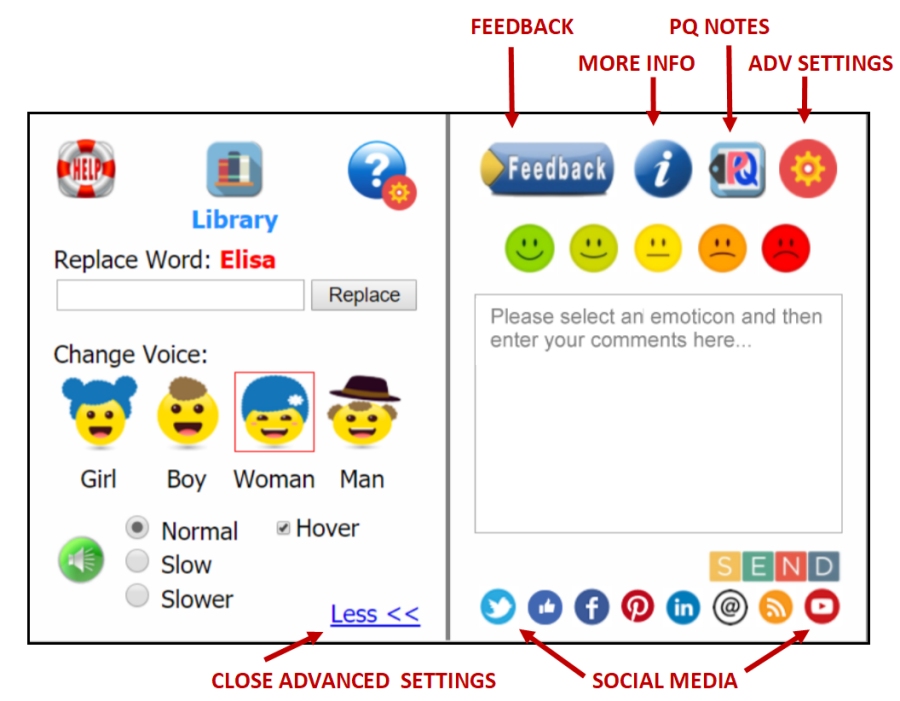

 Feedback – Your feedback is extremely important to us! Please share your suggestions and criticisms and help us learn to improve our work. Feedback is the default mode for the Advanced settings window of the Help / Settings dialog box. To share feedback please select the emoticon that best represents your thoughts or feelings about the page you were viewing, enter your comments where indicated, and press “send”.
Feedback – Your feedback is extremely important to us! Please share your suggestions and criticisms and help us learn to improve our work. Feedback is the default mode for the Advanced settings window of the Help / Settings dialog box. To share feedback please select the emoticon that best represents your thoughts or feelings about the page you were viewing, enter your comments where indicated, and press “send”.

 Information – Clicking the information button will display (where applicable) attributions, citations, and credits for the page you are viewing.
Information – Clicking the information button will display (where applicable) attributions, citations, and credits for the page you are viewing.

 PQ Notes – Clicking the PQ Notes button will display notes from the author to the educator or parent working with a learner. Pages that feature “stop and read” words will contain a list of the PQs used in the “stop and read” words. Clicking on a PQ description listed in the notes will provide you with a detailed explanation of that PQ. (See: Steward Resources)
PQ Notes – Clicking the PQ Notes button will display notes from the author to the educator or parent working with a learner. Pages that feature “stop and read” words will contain a list of the PQs used in the “stop and read” words. Clicking on a PQ description listed in the notes will provide you with a detailed explanation of that PQ. (See: Steward Resources)

 Advanced Settings (for “Stewards“) Clicking the Advanced Settings button will display optional settings that can be used by stewards to connect the PQ Pop-Up to other tools in the Magic Ladder System. For example, clicking “WordScope”:
Advanced Settings (for “Stewards“) Clicking the Advanced Settings button will display optional settings that can be used by stewards to connect the PQ Pop-Up to other tools in the Magic Ladder System. For example, clicking “WordScope”:
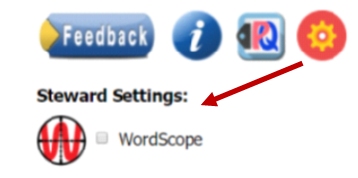
 …will add the WordScope button
…will add the WordScope button  to the PQ Pop-Up which when clicked will pass the word in the Pop-up to the WordScope application (see WordScope manual for more information).
to the PQ Pop-Up which when clicked will pass the word in the Pop-up to the WordScope application (see WordScope manual for more information).

 Note: changes to Advanced Settings will persist until changed but will reset on each new visit.
Note: changes to Advanced Settings will persist until changed but will reset on each new visit.
 Social Media – Please share our pages with your social network.
Social Media – Please share our pages with your social network.
 Using Copy-Paste-PQ
Using Copy-Paste-PQ
With Copy-Paste-PQ, learners and stewards can use the PQ Pop-up app with content from any source (including word processors, PDFs, ebooks, and web pages). Once content has been copied to your device’s clipboard, it can be pasted into the Copy-Paste-PQ page where it will be automatically converted into text, ready to read with PQ Pop-Up app support. Learners or stewards can also type directly into the input window and press the ‘Process’ button to have their own words made ready for reading (or teaching) with PQ Pop-Up app support.
 The index page for every library level contains a Copy-Paste-PQ button:
The index page for every library level contains a Copy-Paste-PQ button:  clicking it will open the Copy-Paste-PQ page:
clicking it will open the Copy-Paste-PQ page:

 Pasting: Copy content from any source and paste where indicated. Immediately the page will display the copied content and be ready for reading with the PQ Pop-up App. Once the paste process is complete the Process button will change and become a Reset button. Clicking the reset button will reset the page to be ready for a new paste or for typed text entry.
Pasting: Copy content from any source and paste where indicated. Immediately the page will display the copied content and be ready for reading with the PQ Pop-up App. Once the paste process is complete the Process button will change and become a Reset button. Clicking the reset button will reset the page to be ready for a new paste or for typed text entry.
 Typed Entry: Type text into the input box and press the process button.
Typed Entry: Type text into the input box and press the process button.
 Font Size: Once the content has been pasted or typed and processed, clicking/touching the left side of the font size button will decrease the size of the font. Clicking/touching the right side of the font size button will increase the size of the font.
Font Size: Once the content has been pasted or typed and processed, clicking/touching the left side of the font size button will decrease the size of the font. Clicking/touching the right side of the font size button will increase the size of the font.

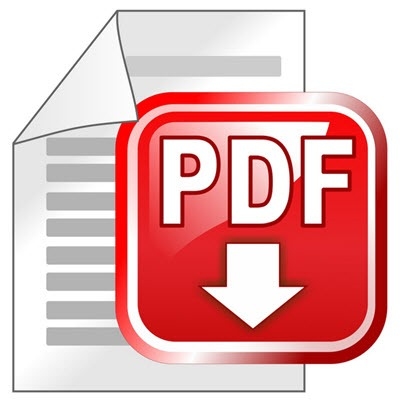
 Print & PDF Output: Once content has been pasted, the content can be printer to paper or PDF. Clicking on either icon will result in a dialog box that allows the print output or pdf to be formatted with or without selected PQs turned on in the print.
Print & PDF Output: Once content has been pasted, the content can be printer to paper or PDF. Clicking on either icon will result in a dialog box that allows the print output or pdf to be formatted with or without selected PQs turned on in the print.
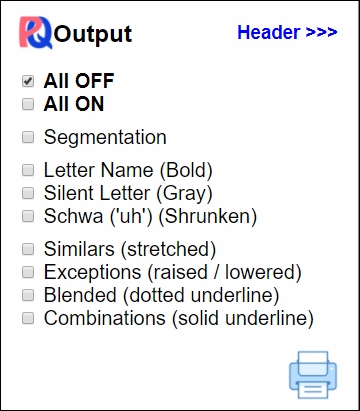
What Are PQs
 PQs is the short name for “Pronunciation Cues”. PQs “cue”, or, “tell” you, which of a letter’s (sometimes groups of letters) sounds it is supposed to sound like. PQs makes letters tell you which of their sounds they are making by changing how the letters look.
PQs is the short name for “Pronunciation Cues”. PQs “cue”, or, “tell” you, which of a letter’s (sometimes groups of letters) sounds it is supposed to sound like. PQs makes letters tell you which of their sounds they are making by changing how the letters look.
 PQs (pronunciation cues) are visible differences in the appearance of letters that tell readers which of a letter’s (or group of letters’) possible sounds is actually to be heard/spoken in the word they are looking at. There are three types of Pcues: Single Letter Simple, Single Letter Exception, and Group Letters. PQs can be learned by just using the PQ Pop-up and paying attention to the way letters look and sound. However, if you are interested in learning the logic behind PQs, click here for a guided tour.
PQs (pronunciation cues) are visible differences in the appearance of letters that tell readers which of a letter’s (or group of letters’) possible sounds is actually to be heard/spoken in the word they are looking at. There are three types of Pcues: Single Letter Simple, Single Letter Exception, and Group Letters. PQs can be learned by just using the PQ Pop-up and paying attention to the way letters look and sound. However, if you are interested in learning the logic behind PQs, click here for a guided tour. 
 PQs for Reading:
PQs for Reading:
Read our article on the ‘case’ behind this way of learning to read.

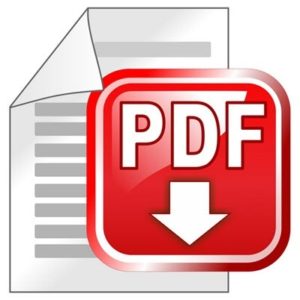
 HOW IT WORKS: Every time a student encounters a word she or he doesn’t recognize, they touch or click it. This brings up a pop-up box containing the word. Clicking on the word in the pop-up results in visual and audible ‘cues’ that reduce and often eliminate the (letter-sound-pattern) confusions in the word. With each click, the cues advance through a consistent series of steps that reveal (where applicable): the word’s segments, long and short sounds, silent letters, letter-sound exceptions, and groupings (blends and combinations). At each step, the student uses the cues to try again to recognize the word. If they can’t, they click again. If all of the cues (seen and heard) after the initial clicks aren’t sufficient to recognize the word, a final click causes the pop-up to animate (visually and audibly) the ‘sounding-out’ of the word and lastly, the playing of the word’s sound as it is normally heard.
HOW IT WORKS: Every time a student encounters a word she or he doesn’t recognize, they touch or click it. This brings up a pop-up box containing the word. Clicking on the word in the pop-up results in visual and audible ‘cues’ that reduce and often eliminate the (letter-sound-pattern) confusions in the word. With each click, the cues advance through a consistent series of steps that reveal (where applicable): the word’s segments, long and short sounds, silent letters, letter-sound exceptions, and groupings (blends and combinations). At each step, the student uses the cues to try again to recognize the word. If they can’t, they click again. If all of the cues (seen and heard) after the initial clicks aren’t sufficient to recognize the word, a final click causes the pop-up to animate (visually and audibly) the ‘sounding-out’ of the word and lastly, the playing of the word’s sound as it is normally heard. 
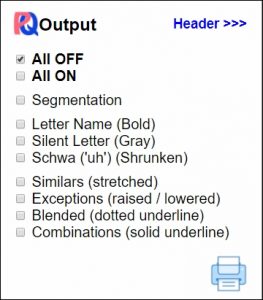
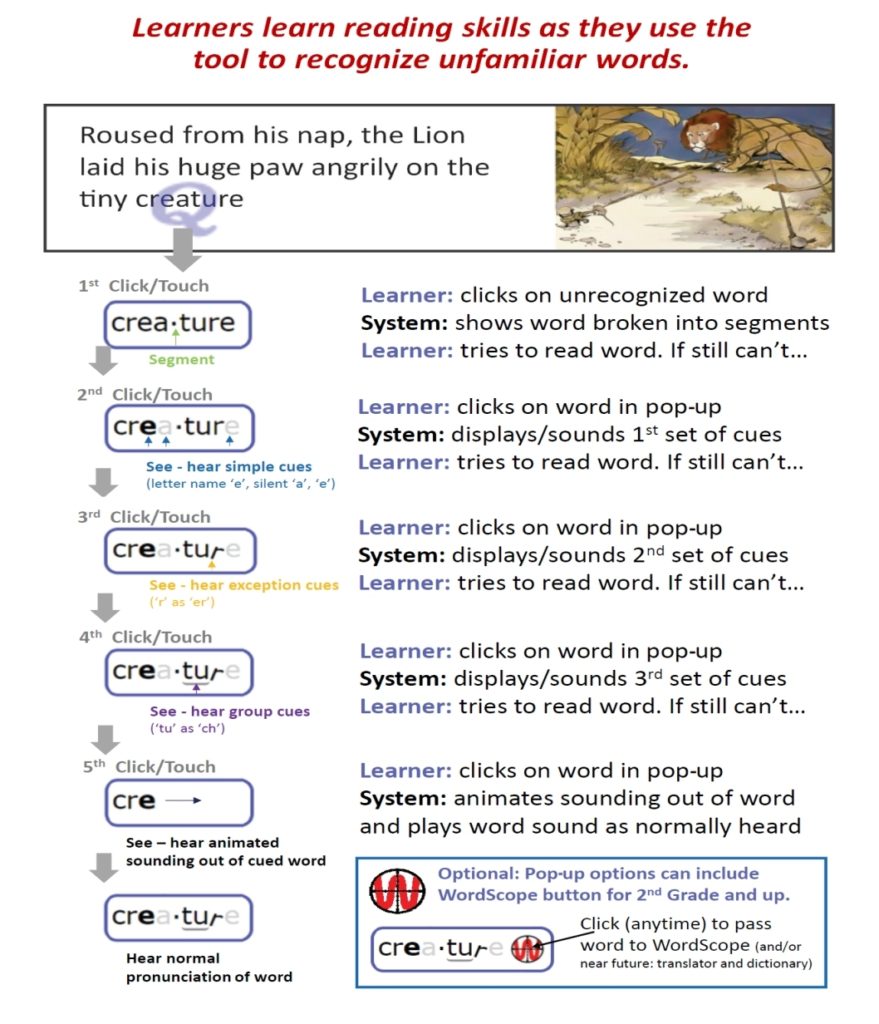
 Stand Alone PQ App
Stand Alone PQ App
 The PQ App is a stand-alone App, Chrome browser extension, or embeddable script that works with ANY word in any html content (soon PDFs), and that can be used by learners of all ages (preschoolers and up) to interactively learn their way to proficient reading. By learning the simple 3 steps of using the app and then simply using the app, learners will learn to read in the most neurologically efficient way possible. The pages in this site use the embedded script so that installation of the App or Chrome browser extension is not required to experience the tool. Installing the stand-alone PQ App will provide the PQ Pop-Up functions exhibited by these pages to virtually every page on the web.
The PQ App is a stand-alone App, Chrome browser extension, or embeddable script that works with ANY word in any html content (soon PDFs), and that can be used by learners of all ages (preschoolers and up) to interactively learn their way to proficient reading. By learning the simple 3 steps of using the app and then simply using the app, learners will learn to read in the most neurologically efficient way possible. The pages in this site use the embedded script so that installation of the App or Chrome browser extension is not required to experience the tool. Installing the stand-alone PQ App will provide the PQ Pop-Up functions exhibited by these pages to virtually every page on the web.
 To install the Chrome browser extension and add the same PQ App functionality experienced on these pages to the html pages of the web and your local machine (soon PDFs) click the following button:
To install the Chrome browser extension and add the same PQ App functionality experienced on these pages to the html pages of the web and your local machine (soon PDFs) click the following button:
Print & PDF Output: Once content has been pasted, the content can be printer to paper or PDF. Clicking on either icon will result in a dialog box that allows the print output or pdf to be formatted with or without selected PQs turned on in the print.
 Print
Print
 &
&
 PDF
PDF
 Output:
Output:
 Once content has been pasted, the content can be printer to paper or PDF. Clicking on either icon will result in a dialog box that allows the print output or pdf to be formatted with or without selected PQs turned on in the print.
Once content has been pasted, the content can be printer to paper or PDF. Clicking on either icon will result in a dialog box that allows the print output or pdf to be formatted with or without selected PQs turned on in the print.
Resources: What is Reading – The Brain’s Challenge – Reading Shame – Reading In The Brain – Oral Language and Reading Comprehension – Children of the Code




















